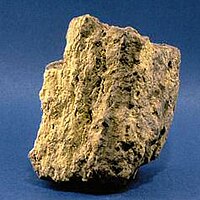
Photo from wikipedia
Abstract The Qinglong deposit is a newly-characterized, large Sb-(Au) deposit in the Youjiang basin (Guizhou, SW China). Four mineralization stages are identified (i.e., pre-ore, early-ore, late-ore and post-ore) in this… Click to show full abstract
Abstract The Qinglong deposit is a newly-characterized, large Sb-(Au) deposit in the Youjiang basin (Guizhou, SW China). Four mineralization stages are identified (i.e., pre-ore, early-ore, late-ore and post-ore) in this study based on crosscutting relationships. Our study shows that the Qinglong Sb mineralization (early-ore stage) was dominated by quartz-stibnite ± fluorite, whilst the Sb-Au mineralization (late-ore stage) comprises quartz-stibnite ± pyrite. Electron Probe Microanalysis (EPMA) indicates that the Au is present as Au1+ in the arsenian pyrite. Besides, our new fluid inclusion data from fluorite, stibnite and quartz show that the Sb-Au-rich hydrothermal fluids were derived from the mixing fluids consisting of H2O, NaCl, hydrocarbon and minor CO2. In the early-ore stage, the ore-forming fluids are characterized by medium to low temperatures (161–294 °C, mean: 220 °C), medium to low salinities (0.35–13.18 wt% NaCl equiv.), low pH, and the presence of hydrocarbons and CO2. In comparison, the late-ore stage ore-forming fluids are featured by low temperatures (113–255 °C, mean: 175 °C), low salinities (0.18–6.30 wt% NaCl equiv.) and nearly neutral pH. The δ34S∑S values (−2.8 to 2.3‰) of the ore-forming fluids suggest that the sulfur at Qinglong was dominantly magmatic-derived. From the early-ore to late-ore stage, the ore-forming fluid temperature and oxygen fugacity (fO2) decrease but the pH increases (from acidic to neutral). Such physicochemical transition may have significantly decreased the Sb solubility from 10 s to 100 s of ppm to 0.001 ppm. Therefore, we propose that fluid mixing was the main process that substantially reduced the fluid temperature and oxygen fugacity, which effectively lowered the Sb solubility and led to abundant stibnite precipitation. The stibnite precipitation had likely decreased the H2S concentrations of the ore-forming fluids, thereby destabilizing the AuHS0 complexes in the fluids and caused local Au precipitation.
Journal Title: Ore Geology Reviews
Year Published: 2018
Link to full text (if available)
Share on Social Media: Sign Up to like & get
recommendations!